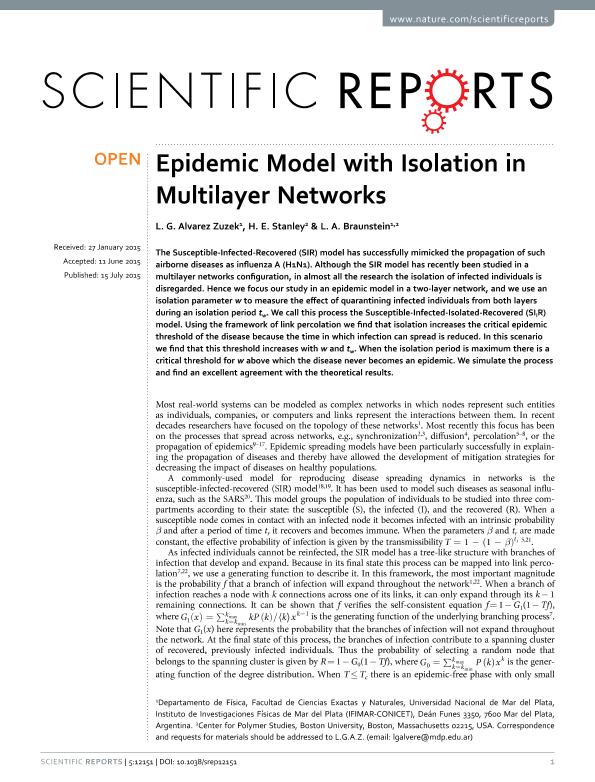Mostrar el registro sencillo del ítem
dc.contributor.author
Alvarez Zuzek, Lucila Gisele

dc.contributor.author
Stanley, H. E.
dc.contributor.author
Braunstein, L. A.
dc.date.available
2016-11-15T15:22:18Z
dc.date.issued
2015-07
dc.identifier.citation
Alvarez Zuzek, Lucila Gisele; Stanley, H. E.; Braunstein, L. A.; Epidemic model with isolation in multilayer networks; Nature Publishing Group; Scientific Reports; 5; 1215; 7-2015; 1-7
dc.identifier.issn
2045-2322
dc.identifier.uri
http://hdl.handle.net/11336/8221
dc.description.abstract
The Susceptible-Infected-Recovered ($SIR$) model has successfully mimicked the propagation of such airborne diseases as influenza A (H1N1). Although the $SIR$ model has recently been studied in a multilayer networks configuration, in almost all the research the isolation of infected individuals is disregarded. Hence we focus our study in an epidemic model in a two-layer network, and we use an isolation parameter $w$ to measure the effect of quarantining infected individuals from both layers during an isolation period $t_w$. We call this process the Susceptible-Infected-Isolated-Recovered ($SI_IR$) model. Using the framework of link percolation we find that isolation reduces the critical epidemic threshold of the disease because} the time in which infection can spread is reduced. In this scenario we find that this threshold increases with w and t_w. When the isolation period is maximum there is a critical threshold for $w$ above which the disease never becomes an epidemic. We also find that epidemic models, like $SIR$ overestimate the critical epidemic threshold. We simulate the process and found an excellent agreement with the theoretical results.
dc.format
application/pdf
dc.language.iso
eng
dc.publisher
Nature Publishing Group

dc.rights
info:eu-repo/semantics/openAccess
dc.rights.uri
https://creativecommons.org/licenses/by/2.5/ar/
dc.subject
Complex Netorks
dc.subject
Multilayer Networks
dc.subject
Epidemic Models
dc.subject
Percolation
dc.subject.classification
Otras Ciencias Físicas

dc.subject.classification
Ciencias Físicas

dc.subject.classification
CIENCIAS NATURALES Y EXACTAS

dc.title
Epidemic model with isolation in multilayer networks
dc.type
info:eu-repo/semantics/article
dc.type
info:ar-repo/semantics/artículo
dc.type
info:eu-repo/semantics/publishedVersion
dc.date.updated
2016-11-14T19:43:43Z
dc.journal.volume
5
dc.journal.number
1215
dc.journal.pagination
1-7
dc.journal.pais
Estados Unidos

dc.description.fil
Fil: Alvarez Zuzek, Lucila Gisele. Consejo Nacional de Investigaciones Científicas y Técnicas. Centro Científico Tecnológico Mar del Plata. Instituto de Investigaciones Físicas de Mar del Plata; Argentina
dc.description.fil
Fil: Stanley, H. E.. Boston University; Estados Unidos
dc.description.fil
Fil: Braunstein, L. A.. Consejo Nacional de Investigaciones Científicas y Técnicas. Centro Científico Tecnológico Mar del Plata. Instituto de Investigaciones Físicas de Mar del Plata; Argentina. Boston University; Estados Unidos
dc.journal.title
Scientific Reports
dc.relation.alternativeid
info:eu-repo/semantics/altIdentifier/url/http://www.nature.com/articles/srep12151
dc.relation.alternativeid
info:eu-repo/semantics/altIdentifier/url/https://www.ncbi.nlm.nih.gov/pmc/articles/PMC4502411/
dc.relation.alternativeid
info:eu-repo/semantics/altIdentifier/doi/http://dx.doi.org/10.1038/srep12151
dc.relation.alternativeid
info:eu-repo/semantics/altIdentifier/url/https://arxiv.org/abs/1412.1430
Archivos asociados
